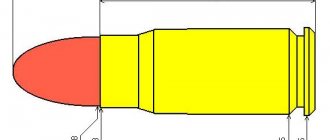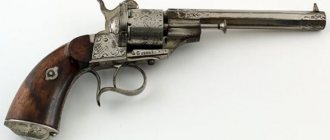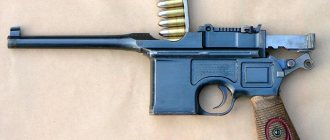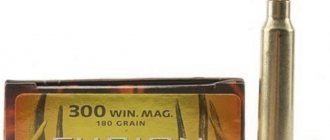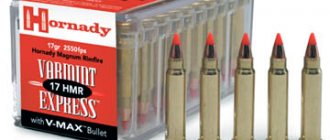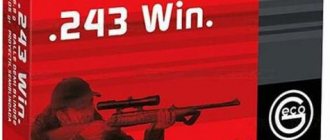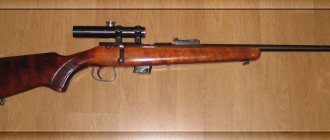Origins of the cartridge
The world famous Parabellum pistol had an ancestor, the pistol of the German gunsmith Hugo Borchard. It was called K-93. Its standard ammunition was a 7.65 mm bottle-shaped cartridge with a 9 mm cylinder diameter.
Gunsmiths considered the K-93 pistol successful. However, its production was complex, expensive and material-intensive. Its ammunition was expensive and difficult to manufacture. Borchard and merchant Luger took steps to improve this pistol. In 1902 they created the legendary Parabellum. Its cartridge was also transformed: to increase power and reduce the cost of production, the bottleneck was cut off.
The pistol cartridge became known as 9×19 PARA. The pistol and its ammunition were adopted by the German Navy in 1904. And in 1908 the entire German army was armed with it. Subsequently, Parabellum became so popular that many countries around the world, including Russia, began to buy it.
9x19 Luger/Parabellum cartridge
The 9 mm Parabellum cartridge (on the North American continent better known under the name of its creator - Georg Lugger - 9 mm Luger, as well as under the designation 9 mm NATO pistol cartridge) is the only cartridge that, over its more than a century of life, has deserved to be called simply “cartridge 9 mm".
Georg Luger created the 9x19 cartridge when the Kaiser's German Navy showed interest in a Parabellum pistol of his design, but considered its original 7.65mm caliber insufficient.
9x19 (early version)
In 1902, to increase the power of the Parabellum pistol, Luger changed the shape of the 7.65 mm cartridge case from bottle to cylindrical, connecting it to a 9 mm cartridge bullet.
In 1904, the German Navy, followed by the German Army in 1908, adopted the Luger pistol and a new cartridge for it.
9×19
Initially, the 9×19 cartridge had a jacketed bullet with a flat head (in the form of a truncated cone). In 1915 it was replaced by a bullet with an ogive head. The bullet initially had a nickel silver-clad steel shell with a lead core. Since 1917, the steel bullet casing has been varnished with tombac.
Standard 9x19 Luger / Parabellum cartridges (cartridges with standard barrel pressure) have a bullet weight from 6 to 10.7 g, muzzle velocity from 300 to 450 m/s, muzzle energy from 450 to 550-600 Joules.
9x19 Luger FMJ;
FMJ nick; HP (RP); HP (CBC); HP nick (from left to right) 9x19 cartridge cases are available in both brass and copper-plated steel. The bullet can be of any type, including plastic. General purpose bullet - jacketed with a lead core. The shell is bimetallic or steel, clad with tombac.
Cartridges produced for civilian and police weapons were equipped with almost all types of bullets produced in the world.
The good ballistic properties of the 9x19 cartridge made it the standard ammunition for pistols and submachine guns in most countries of the world after World War II.
The 9x19 Luger / Parabellum cartridge is produced in almost all countries of the world.
9x19 Luger from different manufacturers
In principle, the specification of the type 9x19 “Parabellum” or 9x19 “Luger” only gives an idea of the geometric dimensions of the sleeve. There is no identity between these designations: in some countries the first abbreviation refers to military cartridges, and the second to cartridges for the civilian market, while in Finland the first abbreviation refers to cartridges with cartridges with a Berdan-type capsule socket, the second to a Boxer-type capsule socket "(the successor to the Berdanov capsule, which almost replaced the Berdanov capsule). Some European companies still use the designation 9x19mm "Luger" for cartridges supplied to the American market, while for other purchasing countries the same cartridges are sold as 9x19 "Parabellum". Some produce cartridges with a main bullet mass of 7.5 g, and others with a mass of 8 g.
However, the external geometric dimensions of the cartridge case, identical within tolerance, unite thousands of the most diverse cartridges in the 9x19 caliber family, developed in all corners of the world since 1902.
9x19 Luger (standard version)
9x19 cartridges have several basic modifications that differ in power: 9-mm “parabellum” with a standard impulse (i.e. the pressure in the barrel bore does not exceed the norm), the so-called “standard” cartridge, 9- mm +P (i.e. the pressure in the barrel bore is high (increased)), 9 mm +P+ (i.e. the pressure in the barrel bore is very high - this type of cartridge is used by the police, less often in “civilian” pistols), 9 -mm NATO (in service with the armies of NATO countries). There are also so-called “automatic” 9x19 cartridges intended for submachine guns, which in the West have the general designation “series B 3” (The use of such cartridges in any pistols is unacceptable, because due to much more, even compared to the 9x19-mm cartridge "NATO" maximum permissible pressure of powder gases can rupture the barrel. They can only be used in submachine guns.).
9-mm NATO cartridges in their characteristics are very close to 9-mm +P+ cartridges and the use of cartridges of this type in weapons designed for the standard 9x19 cartridge (for example, in old pistols such as “Parabellum-08” or “Walter P-38” ) is unacceptable because it can lead to the destruction of the weapon. Modern weapons, such as, for example, pistols “Glock-17”, “Beretta-92 FS”, etc., are produced taking into account the fact that 9-mm +P+ or 9 mm cartridges will probably be used for shooting -mm NATO. True, experts do not advise owners of such pistols as, for example, Glock-17, Beretta-92 FS, etc., to always shoot with 9-mm +P+ or 9-mm NATO cartridges; it is better to shoot with a “standard” cartridge 9x19, since in the case of firing with a “standard” 9x19 cartridge, the barrel life will be much higher than in the case of firing with 9x19 +P, 9x19 +P+ or 9x19 NATO cartridges.
The standard 9 mm NATO cartridge has a bullet weight of 7.82 grams at a muzzle velocity of 390-400 m/s or 8.43 grams at a muzzle velocity of about 375 m/s. Muzzle energy is about 600 Joules.
It is also worth mentioning the fact that Russia also switched to the “European standard”, accepting the 9x19 caliber cartridge (and its modifications) as one of the standard cartridges for military weapons (and also due to the fact that the 9x18 PM cartridge turned out to be powerless against modern means of personal armor protection ) at the Tula Cartridge Plant they developed its improved modification - the 9x19 PP cartridge.
9x19 PP
The new 9x19 armor-piercing cartridge is equipped with a semi-jacketed bullet with a steel core.
The head part of the steel core is flat, the diameter of the cylindrical part is about 6 mm with a length of 16 mm; the core is enclosed in an aluminum jacket and a bimetallic shell. A bullet with a total mass of 5.1 grams at a pressure in the barrel bore of up to 2200 atm. (220 mPa) has a speed of 420 m/s at a distance of 10 meters from the muzzle, which corresponds to a kinetic energy of 714 J. This energy is enough to penetrate 7 mm steel plate. True, only early 9x19 PP cartridges had such acceptable pressure. 7N21
However, later, the working pressure of serial armor-piercing cartridges 7N21 (developed by TsNIITOCHMash, cartridge designer - I.P. Kasyanov) was seriously increased, which turned out to be higher than that of 9x19 caliber cartridges, designed for use only in submachine guns.
7N31
The later 7N31 cartridge (developed by KBP) has even more “strict” levels of maximum permissible pressure, even compared to the 7N21 cartridge, which leads not only to unnecessary loads on the weapon, but also does not make it possible to achieve acceptable accuracy and accuracy of fire.
It is also worth noting that Russian ammunition manufacturers produce the 9x19 Luger cartridge with “standard” operating pressure with both brass, steel and bimetallic cases. It should also be noted that the cartridges produced by the Tula TPZ have external sealing of the bullet and an increased (compared to other Russian cartridge factories) thickness of the varnish layer at the barrel of the case.
The beginning of a long journey
Initially, the Luger 2 9x19 cartridge was equipped with 2 types of bullets: with a flat top and with a spherical top. In 1915, production of flat-tip bullets was discontinued. The option with a bullet with a spherical tip turned out to be the most successful. He maintained the necessary and correct balance between the dimensions of the cartridge and the weapon for them. There are more than a hundred different types and models of small arms that use the Luger 9x19 cartridge.
In 1917, the cartridge case and bullet began to be coated with a special water-repellent varnish. Since that time, the standard 9x19 mm cartridge has remained virtually unchanged.
Its high ballistic performance, as well as ease of production, which was tested in numerous wars of the 20th century, led to the fact that it became the most widespread in the world.
The weapon and cartridge "Luger" 9x19 ("Parabellum") are recognized as the best products of short-barreled weapons intended for self-defense in the 20th century. Shooting from a Luger or Parabellum pistol recorded the retention of lethal force at a distance of up to 100-120 meters. The greatest efficiency was achieved at a distance of up to 50 meters. At a distance of 10 m, a 9x19 mm cartridge bullet, when hitting at an angle of 90 degrees, pierced a steel helmet. The bullet pierced through a pine board 150 mm thick at a distance of 50 meters. At this distance the accuracy was about 50 mm.
In addition to the classic pistol cartridge, Germany produced several varieties of them. The Luger cartridge (DWM 480 D) with linear parameters 9x19 was intended for firing from the Parabellum carbine. The carbine had an elongated barrel and a wooden butt. The DWM 480 D had the same dimensions as the DWM-480 C pistol cartridge, but the gas pressure of the carbine cartridge was 20% higher. They were not allowed to be used in Luger pistols. These ammunitions were distinguished by markings. Moreover, the carbine cartridge had a blackened cartridge case.
Ammunition characteristics
Standard characteristics of the cartridge:
- caliber 9 mm;
- initial bullet speed from 410 to 435 meters per second;
- cartridge length 29.7 mm;
- sleeves 19.15 mm;
- loaded cartridge weight from 7.2 to 12.5 grams;
- the bullet weighs from 5.8 to 10.2 grams.
Currently, the Luger 9x19 cartridge is produced by many countries. They are also made in the Russian Federation. In NATO countries, it is customary that “Parabellum” is the name for live ammunition, and the name “Luger” is assigned to ammunition intended for the civilian market.
Options and modifications
The name 9x19mm PARA refers only to the geometry of the cartridge. More than 2000 modifications of this type of ammunition are known. Cartridge cases are made in steel, brass, bimetallic and plastic. The bullet is also very diverse, including plastic. A standard general use bullet has a jacketed lead core weighing between 7.5 and 8 grams. Shell made of bimetal or steel, clad with tampak (application of a bimetallic coating, mainly containing copper).
Bullets chambered for the 9x19 Luger cartridge are made in a variety of shapes and from a variety of materials. The ammunition is used to solve very unusual problems. Thus, 9x19 mm police bullets made in Finland are a lead bubble, empty inside. Having hit a person, the bullet is crushed, hitting the target with a painful shock, but does not cause bodily harm.
There are also other modifications of 9x19 mm cartridges aimed at guaranteed destruction of a living target. Thus, armor-piercing bullets, in which the core is hardened steel and is made like a screw, not only pierce the body armor, but are also screwed into it, penetrating very deeply.
There are a lot of varieties of 9x19 cartridges in terms of their classification. They are usually distinguished based on muzzle energy indicators.
In the European market, a reading of 450 joules is considered standard. Cartridges of 550 joules and above are considered strong, intended for equipping military units. Cartridges with muzzle energy below 400 joules are weak ammunition used by specialists. tasks.
In the American market, the standard muzzle energy is 300-400 joules. This ammunition is designated 9x19 Luger. The same cartridges that provide energy above 450 joules are classified as special-purpose ammunition. They are designated 9×19 “Parabellum”.
Description
Today this ammunition is the most widely used pistol and submachine gun cartridge in the world. The production of its various versions has been established in many countries around the world.
This is interesting: the name “Parabellum” was taken from the Latin proverb - Si vis pacem, para bellum - “If you want peace, prepare for war.”
9x19 mm Parabellum cartridge
In addition to this name, the cartridge is also known as 9x19 Luger. As for markings, the 9x19 mm PARA variant of the name is usually used for 9x19 mm NATO combat cartridges, and the second variant is used for civilian cartridges.
The cartridge originally had a conical bullet with a flat part in front. This design turned out to be unsuccessful, because problems arose when feeding a cartridge into the chamber from the magazine. Later, in 1915, a bullet with a lead core in a steel jacket received a streamlined head. And since 1917, the bullet has been clad with tombak.
Design of the 9x19 mm Luger cartridge
Today, ammunition is produced both in the Russian Federation and in almost all countries of the world that produce cartridges in general. Today there are more than 2000 modifications of this cartridge. As you know, cartridges are produced with steel, brass, plastic, bimetallic sleeves, and the bullet can be of absolutely any shape and type from a wide variety of materials. It all depends on what purpose the cartridge should serve. Ideally, a general purpose bullet has a lead core and a bimetallic/steel jacket.
History of the cartridge in World War II
The 9x19 Luger cartridge was used by all warring countries in World War II.
Naturally, it was most actively used by Germany. It was the main cartridge for the MP-18, MP-28, MP-34, MP-35, MP-38, MP-40 submachine guns.
Experiencing a shortage of lead at cartridge factories in Germany, they began to make an iron core, only coated with lead. The bullet had a black jacket. During wartime, they began to produce a non-jacketed version of the bullet, its color was dark gray. It was obtained by sintering iron powder at high temperatures into a solid material.
Germany also produced special 9x19 cartridges, namely:
- Beschusspatrone 08 - gunpowder with a reinforced charge, and its power was 75% more.
- Kampfstoffpatrone 08 - the bullets were poisoned. SS units have been supplied with them since 1944. How many ammunition of this type were fired has not been established.
— Nahpatrone 08 — intended for weapons with a silencer. The powder charge was smaller, but the bullet weight differed from the standard one to a greater extent.
— Pistolenpatrone 08 fur Tropen — this type is intended for use in tropical climates. He had a heat-protective cartridge case mask to prevent the gunpowder from heating up.
- Sprengpatrone 08 - explosive cartridge, an azoimide ball was pressed into the bullet.
Cartridge marking
9x19 mm Parabellum cartridges have several basic modifications that differ in power:
- 9x19 mm cartridges with standard impulse (pressure in the barrel bore);
- 9x19 mm +P cartridges with increased pressure in the barrel;
- 9x19 mm +P+ cartridges with very high pressure in the barrel - used by police forces, sometimes in the civilian sector;
- 9x19 mm NATO, which are in service with NATO member countries.
Swedish cartridge 9x19 mm Parabellum
There are also cartridges that are used for submachine guns - this is the so-called. 9x19 mm machine gun cartridges under the “Western” designation “series B 3”. Such cartridges cannot be used in pistols due to the enormous pressure in the barrel.
This is interesting: the Finnish version of the police cartridge is ammunition with a lead bullet-bubble, with emptiness inside. Such a bullet is crushed upon impact and does not cause serious bodily harm.
Today, the 9x19 mm Luger cartridge is used in more than 100 different firearms.
Luger cartridges in modern Russia
The 9×19 cartridge has also found use in the modern Russian army. In March 2003, the armed forces and law enforcement agencies received new pistols instead of outdated PMs:
— 9-mm PYa pistol (Yarygin pistol) chambered for 9×19 cartridge.
- 9 mm pistol GSh-18 pistol (Gryazev and Shipunov). Designed for the 9x19 pistol cartridge. Ammunition for the pistol was developed by the designers themselves.
Russian carbines
Russian manufacturers produce only one carbine chambered for the 9x19 Luger cartridge. It is called “Vepr-Luger”, the factory GDP index is 132. This weapon is manufactured by Vyatsky.
The domestic one differs from the world famous Luger carbine in almost every way. From the prototype, he inherited only the bolt box. There is no gas release mechanism. The chamber is reloaded and assembled by a freely swinging bolt. The barrel length reaches 420 mm.
According to the technical data of the carbine, the Vepr-Luger is intended for hunting at short distances. The main objects are small predators and rodents. The manufacturer recommends equipping the carbine with 9x19 Luger cartridges, which are manufactured at the Barnaul Cartridge Plant. These ammunition have a lateral dispersion of 85 mm at a distance of 25 m. The cartridge pressure is 2350 bar. Bullet weighing 9.4 g. Initial speed 325 meters per second.
However, the Novosibirsk Cartridge Plant, which produces similar cartridges, offers a much smaller dispersion radius: only 32 mm at a distance of 25 m.
Russian modifications of the cartridge
In the Russian Federation, 9x19 mm Parabellum cartridges began to be produced in the 90s. Initially, the cartridges were exported. At the end of the 90s to the beginning of the 2000s, it was decided to switch to a new standard 9x19 mm cartridge for the needs of the army and the Ministry of Internal Affairs instead of 9x18 mm, which was no longer coping with its duties. For the new weapon, cartridges with improved ballistic characteristics were developed. The following Russian modifications of the 9x19 mm Parabellum cartridge are known:
- 9x19 PS zh (7N21) - a cartridge with a bullet with an initial speed of 445-470 m/s with a steel core, developed in the early 90s. The power is similar to NATO 9x19 mm NATO cartridges. Capable of piercing a 4-mm steel plate St.3 at a distance of 55 m. Developed at TsNIITochmash.
Cartridge 7N21 9x19 mm Parabellum - 9x19 PBP zh (7N31) - a cartridge with a semi-sheathed bullet has a heat-strengthened steel core, bare at the head. The bullet has a huge initial speed of up to 600 m/s and ensures reliable penetration of body armor of the 2nd protection class according to GOST R 50744-95. There is a more modern version of the cartridge with increased penetration - 7N31. It is capable of penetrating an 8 mm steel plate at a distance of 20 m. Developed by the Tula Instrument Engineering Design Bureau in the early 2000s.
Cartridge 7N31 9x19 mm Parabellum - 9x19 PP gs (gzh) (7N30) - cartridge with increased penetration. A bullet with an initial speed of 420-445 m/s pierces a 4 mm steel plate at a distance of 60 m and a class 2 body armor Zh-86-2 at a distance of 25 m.
Cartridge 7N30 9x19 mm Parabellum - 9x19 P gzh (7N35) - a cartridge with a bullet with a lead core, not mass-produced.
- 9x19 T gzh (7 T4) - cartridge with a tracer bullet.
- 9x19 PRS GS - a cartridge with an initial bullet speed of 345-385 m/s, which has a reduced ricochet ability.
- 9x19 PSO gzh is a sports cartridge with a bullet speed of 340 m/s.
- 9x19 Luger is a sporting and hunting cartridge.
- 9x19 PFO is a serial ammunition produced by the Tula Cartridge Plant for the federal forces.
- 4.5x19 - cartridge for two media. Designed for shooting underwater from the GSh-18 pistol.



